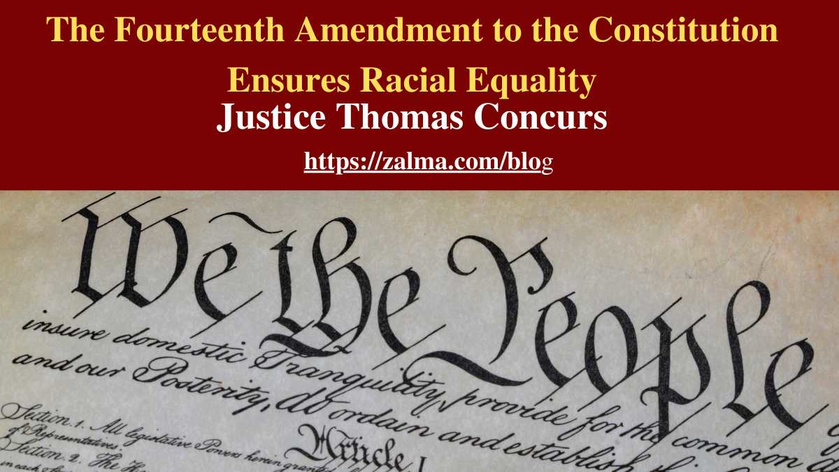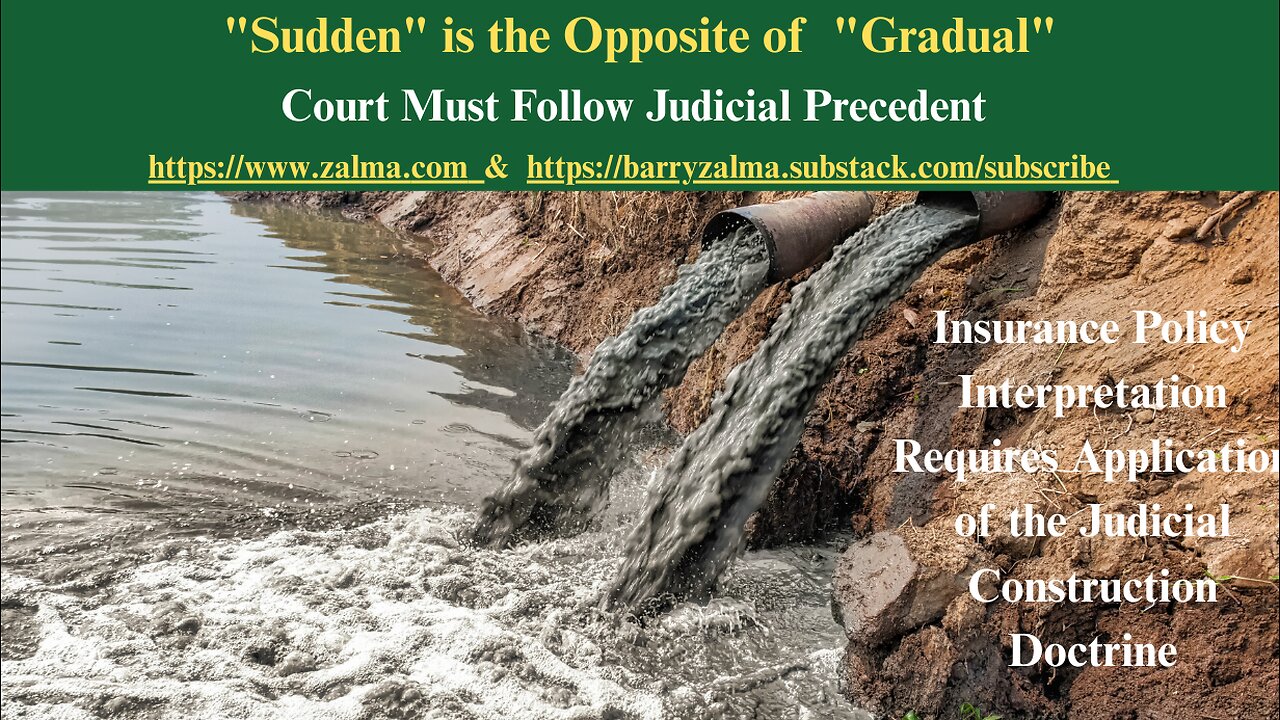
Justice Thomas Concurs
Barry Zalma
Jun 30, 2023
The Fourteenth Amendment to the Constitution Ensures Racial Equality
Read the full article at https://www.linkedin.com/.../fourteenth-amendment... and at https://zalma.com/blog.
STUDENTS FOR FAIR ADMISSIONS, INC., PETITIONER 20–1199 v. PRESIDENT AND FELLOWS OF HARVARD COLLEGE ON WRIT OF CERTIORARI TO THE UNITED STATES COURT OF APPEALS FOR THE FIRST CIRCUIT STUDENTS FOR FAIR ADMISSIONS, INC., PETITIONER 21–707 v. UNIVERSITY OF NORTH CAROLINA, ET AL
I’m an insurance law expert and seldom get involved in issues of race. I was one of very few Jews at my college and had a cross burned on the lawn of an old apartment where I was housed since there was no room in a dormitory. One student always greeted me with the comment: “Six Million and One, Zalma.”
I managed to graduate and made a few friends. One of the few black students was a native of the Congo who was shocked to learn that my brother had married a native of the Congo who was actually a Belgian Jew. Discrimination is wrong but it can be overcome and this decision of the Supreme Court has made it unconstitutional. I graduated from college in 1964 long after the 14th Amendment and its statement of the Constitution’s requirement that no one should either suffer or profit from discrimination. I thank members of the Supreme Court for recognizing the mandate of the Constitution before I shuffle off this mortal coil.
If you have the time I suggest that you read the full opinion and the various concurrences and the dissents at https://www.supremecourt.gov/opinions/22pdf/20-1199_hgdj.pdf
I have excepted what I believe to be important parts of Justice Thomas’ concurrence, in a lengthy 58 pages wrote cogently, among other things:
[T]he Fourteenth Amendment—ensures racial equality with no textual reference to race whatsoever. The history of these
measures’ enactment renders their motivating principle as
clear as their text: All citizens of the United States, regard-
less of skin color, are equal before the law.
As enacted, the text of the Fourteenth Amendment pro-
vides a firm statement of equality before the law. It begins
by guaranteeing citizenship status, invoking the
“longstanding political and legal tradition that closely asso-
ciated the status of citizenship with the entitlement to legal
equality.” Vaello Madero, 596 U. S., at ___ (THOMAS, J.,
concurring) (slip op., at 6) (internal quotation marks omit-
ted). It then confirms that States may not “abridge the
rights of national citizenship, including whatever civil
equality is guaranteed to ‘citizens’ under the Citizenship
Clause.” Id., at ___, n. 3 (slip op., at 13, n. 3). Finally, it
pledges that even noncitizens must be treated equally “as
individuals, and not as members of racial, ethnic, or reli-
gious groups.” Missouri v. Jenkins, 515 U. S. 70, 120–121
(1995) (THOMAS, J., concurring).
Despite the extensive evidence favoring the colorblind
view, as detailed above, it appears increasingly in vogue to
embrace an “antisubordination” view of the Fourteenth
Amendment: that the Amendment forbids only laws that
hurt, but not help, blacks. Such a theory lacks any basis in
the original meaning of the Fourteenth Amendment.
To satisfy strict scrutiny, universities must be able to es-
tablish a compelling reason to racially discriminate.
The Constitution’s colorblind rule reflects one of the core
principles upon which our Nation was founded: that “all
men are created equal.” Those words featured prominently
in our Declaration of Independence and were inspired by a
rich tradition of political thinkers, from Locke to Montes-
quieu, who considered equality to be the foundation of a just
government.
Even taking the desire to help on its face, what initially
seems like aid may in reality be a burden, including for the
very people it seeks to assist. Take, for example, the college
admissions policies here. “Affirmative action” policies do
nothing to increase the overall number of blacks and His-
panics able to access a college education. Rather, those ra-
cial policies simply redistribute individuals among institu-
tions of higher learning, placing some into more competitive
institutions than they otherwise would have attended. See
T. Sowell, Affirmative Action Around the World 145–146
(2004). In doing so, those policies sort at least some blacks
and Hispanics into environments where they are less likely
to succeed academically relative to their peers.
Finally, it is not even theoretically possible to “help” a
certain racial group without causing harm to members of
other racial groups.
Whatever their skin color, today’s youth simply are not responsible for instituting the segregation of the 20th century, and they do not shoulder the moral debts of their ancestors. Our Nation should not punish today’s youth for the sins of the past.
In fact, all racial categories are little more than stereotypes, suggesting that immutable characteristics somehow conclusively determine a person’s ideology, beliefs, and abilities. Of course, that is false. … Members of the same race do not all share the exact same experiences and viewpoints; far from it. A black person from rural Alabama surely has different experiences than a black person from Manhattan or a black first-generation immigrant from Nigeria, in the same way that a white person from rural Vermont has a different perspective than a white person from Houston, Texas. Yet, universities’ racial policies suggest that racial identity “alone constitutes the being of the race or the man.” J. Barzun, Race: A Study in Modern Superstition 114 (1937). That is the same naked racism upon which segregation itself was built. Small wonder, then, that these policies are leading to increasing racial polarization and friction. This kind of reductionist logic leads directly to the
“disregard for what does not jibe with preconceived theory,”
providing a “cloa[k] to conceal complexity, argumen[t] to the
crown for praising or damning without the trouble of going
into details”—such as details about an individual’s ideas or
unique background. Ibid. Rather than forming a more plu-
ralistic society, these policies thus strip us of our individu-
ality and undermine the very diversity of thought that uni-
versities purport to seek.
Racialism simply cannot be undone by different or more racialism. Instead, the solution announced in the second founding is incorporated in our Constitution: that we are all equal, and should be treated equally before the law without regard to our race.
With the passage of the Fourteenth Amendment, the people of our Nation proclaimed that the law may not sort citizens based on race. It is this principle that the Framers of the Fourteenth Amendment adopted in the wake of the Civil War to fulfill the promise of equality under the law. And it is this principle that has guaranteed a Nation of equal citizens the privileges or immunities of citizenship and the equal protection of the laws. To now dismiss it as “two-dimensional flatness,” post, at 25 (J ACKSON, J., dissenting), is to abdicate a sacred trust to ensure that our “honored dead . . . shall not have died in vain.” A. Lincoln, Gettysburg Address (1863)
If social reorganization in the name of equality may be justified by the mere fact of statistical disparities among racial groups, then that reorganization must continue until these disparities are fully eliminated, regardless of the reasons for the disparities and the cost of their elimination. If blacks fail a test at higher rates than their white counterparts (regardless of whether the reason for the disparity has anything at all to do with race), the only solution will be race-focused measures. If those measures were to result in blacks failing at yet higher rates, the only solution would be to double down. In fact, there would seem to be no logical limit to what the government may do to level the racial playing field—outright wealth transfers, quota systems, and racial preferences would all seem permissible. In such a system, it would not matter how many innocents suffer race-based injuries; all that would matter is reaching the race-based goal.
Even today, affirmative action programs that offer an admissions boost to black and Hispanic students discriminate against those who identify themselves as members of other races that do not receive such preferential treatment.
Historically Black Colleges and Universities (HBCUs) do not have a large amount of racial diversity, but they demonstrate a marked ability to improve the lives of their students.
The great failure of this country was slavery and its progeny. And, the tragic failure of this Court was its misinterpretation of the Reconstruction Amendments, as Justice Harlan predicted in Plessy. We should not repeat this mistake merely because we think, as our predecessors thought, that the present arrangements are superior to the Constitution.
The Court’s opinion rightly makes clear that Grutter is, for all intents and purposes, overruled. And, it sees the universities’ admissions policies for what they are: rudderless, race-based preferences designed to ensure a particular racial mix in their entering classes. Those policies fly in the face of our colorblind Constitution and our Nation’s equality ideal. In short, they are plainly—and boldly—unconstitutional. See Brown II, 349 U. S., at 298 (noting that the Brown case one year earlier had “declare[d] the fundamental principle that racial discrimination in public education is unconstitutional”).
While I am painfully aware of the social and economic ravages which have befallen my race and all who suffer discrimination, I hold out enduring hope that this country will live up to its principles so clearly enunciated in the Declaration of Independence and the Constitution of the United States: that all men are created equal, are equal citizens, and must be treated equally before the law.

Posted on January 2, 2026 by Barry Zalma
ZIFL – Volume 30 Number 1
THE SOURCE FOR THE INSURANCE FRAUD PROFESSIONAL
See the video at https://rumble.com/v73nifg-zalmas-insurance-fraud-letter-january-2-2026.html and at https://youtu.be/vZC1e-_qwDg
Supreme Court of Louisiana Removes Judge
Judge Who Lied to Get Elected Cannot Serve
In In Re: Judge Tiffany Foxworth-Roberts, No. 2025-O-01127, Supreme Court of Louisiana (December 11, 2025) the Louisiana Supreme Court in an opinion by Chief Justice Weimer dealt with the recommendation of the Judiciary Commission of Louisiana (Commission) that Judge Tiffany Foxworth-Roberts be removed from office for:
1. making false and misleading statements regarding her judicial campaigns;
2. making false and misleading statements to police investigating the reported burglary of her car; and
3. withholding information and providing false, incomplete, or misleading information during the investigation by the Office of Special Counsel (OSC), as well as in the proceedings before the Commission....
Montana County Attorney Admits to Insurance Fraud & Is Only Suspended from Practice for 60 Days
Post 5251
Read the full article at https://lnkd.in/gnBaCjmv, see the video at https://lnkd.in/gfpVsyAd and at https://lnkd.in/gC73Nd8z, and at https://zalma.com/blog plus more than 5250 posts.
A Lawyer Who Commits Insurance Fraud and Pleas to a Lower Charge Only Suspended
In The Matter Of: Naomi R. Leisz, Attorney at Law, No. PR 25-0150, Supreme Court of Montana (December 23, 2025) the Montana Office of Disciplinary Counsel (ODC) filed a formal disciplinary complaint with the Commission on Practice (Commission) against Montana attorney Naomi R. Leisz.
On September 25, 2025, Leisz tendered a conditional admission and affidavit of consent. Leisz acknowledged the material facts of the complaint were true and she had violated the Montana Rules of Professional Conduct as alleged by ODC.
ADMISSIONS
Leisz admitted that in April 2022, her minor son was involved in a car accident in which he hit a power pole. Leisz’s son ...
Montana County Attorney Admits to Insurance Fraud & Is Only Suspended from Practice for 60 Days
Post 5251
Read the full article at https://lnkd.in/gnBaCjmv, see the video at https://lnkd.in/gfpVsyAd and at https://lnkd.in/gC73Nd8z, and at https://zalma.com/blog plus more than 5250 posts.
A Lawyer Who Commits Insurance Fraud and Pleas to a Lower Charge Only Suspended
In The Matter Of: Naomi R. Leisz, Attorney at Law, No. PR 25-0150, Supreme Court of Montana (December 23, 2025) the Montana Office of Disciplinary Counsel (ODC) filed a formal disciplinary complaint with the Commission on Practice (Commission) against Montana attorney Naomi R. Leisz.
On September 25, 2025, Leisz tendered a conditional admission and affidavit of consent. Leisz acknowledged the material facts of the complaint were true and she had violated the Montana Rules of Professional Conduct as alleged by ODC.
ADMISSIONS
Leisz admitted that in April 2022, her minor son was involved in a car accident in which he hit a power pole. Leisz’s son ...
Court Must Follow Judicial Precedent
Post 5252
Read the full article at https://www.linkedin.com/pulse/sudden-opposite-gradual-barry-zalma-esq-cfe-h7qmc, see the video at and at and at https://zalma.com/blog plus more than 5250 posts.
Insurance Policy Interpretation Requires Application of the Judicial Construction Doctrine
In Montrose Chemical Corporation Of California v. The Superior Court Of Los Angeles County, Canadian Universal Insurance Company, Inc., et al., B335073, Court of Appeal, 337 Cal.Rptr.3d 222 (9/30/2025) the Court of Appeal refused to allow extrinsic evidence to interpret the word “sudden” in qualified pollution exclusions (QPEs) as including gradual but unexpected pollution. The court held that, under controlling California appellate precedent, the term “sudden” in these standard-form exclusions unambiguously includes a temporal element (abruptness) and cannot reasonably be construed to mean ...


Lack of Jurisdiction Defeats Suit for Defamation
Post 5250
Posted on December 29, 2025 by Barry Zalma
See the video at and at
He Who Represents Himself in a Lawsuit has a Fool for a Client
In Pankaj Merchia v. United Healthcare Services, Inc., Civil Action No. 24-2700 (RC), United States District Court, District of Columbia (December 22, 2025)
FACTUAL BACKGROUND
Parties & Claims:
The plaintiff, Pankaj Merchia, is a physician, scientist, engineer, and entrepreneur, proceeding pro se. Merchia sued United Healthcare Services, Inc., a Minnesota-based medical insurance company, for defamation and related claims. The core allegation is that United Healthcare falsely accused Merchia of healthcare fraud, which led to his indictment and arrest in Massachusetts, causing reputational and business harm in the District of Columbia and nationwide.
Underlying Events:
The alleged defamation occurred when United ...


Zalma’s Insurance Fraud Letter
Read the full article at https://lnkd.in/dG829BF6; see the video at https://lnkd.in/dyCggZMZ and at https://lnkd.in/d6a9QdDd.
ZIFL Volume 29, Issue 24
Subscribe to the e-mail Version of ZIFL, it’s Free! https://visitor.r20.constantcontact.com/manage/optin?v=001Gb86hroKqEYVdo-PWnMUkcitKvwMc3HNWiyrn6jw8ERzpnmgU_oNjTrm1U1YGZ7_ay4AZ7_mCLQBKsXokYWFyD_Xo_zMFYUMovVTCgTAs7liC1eR4LsDBrk2zBNDMBPp7Bq0VeAA-SNvk6xgrgl8dNR0BjCMTm_gE7bAycDEHwRXFAoyVjSABkXPPaG2Jb3SEvkeZXRXPDs%3D
Zalma’s Insurance Fraud Letter (ZIFL) continues its 29th year of publication dedicated to those involved in reducing the effect of insurance fraud. ZIFL is published 24 times a year by ClaimSchool and is written by Barry Zalma. It is provided FREE to anyone who visits the site at http://zalma.com/zalmas-insurance-fraud-letter-2/
Zalma’s Insurance Fraud Letter
Merry Christmas & Happy Hannukah
Read the following Articles from the December 15, 2025 issue:
Read the full 19 page issue of ZIFL at ...












